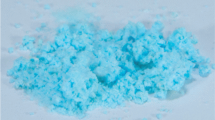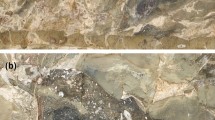Summary
New compositional and optical data are reported for antimonian and antimonianbismuthian varieties of hemusite from epithermal Au-Ag-Cu deposits in Japan. The empirical formula for the antimonian variety, from the Iriki mine is: (Cu5.83Fe0.14Ag0.01)Σ5.98Mo1.03(Sn0.54Sb0.41Te0.03Bi0.02)Σ1.00(S7.85Se0.15)Σ8.00, and that of the Sb-Bi variety from the Kawazu mine is: (Cu5.84Fe0.14Ag0.01)Σ5.99Mo1.03(Sn0.82Sb0.11Bi0.l0Te0.04)Σ1.07(S7.80Se0.12)Σ7.92. The theoretical formula of hemusite is Cu+ 4Cu2+ 2MO4+Sn4+S8, whilst the most probable formula of the Iriki hemusite is Cu+ 4.5CU2+ 1.5Mo4+Sn4+ 0.5Sb5+ 0.5S8, with Sb5+ substituting for Sn4+ and forming (SbS4)3− tetrahedra as might be expected, given that the metal to sulphur ratio is 1, and given the sphalerite-like structure of the mineral. However Bi3+ cannot be so accommodated, resulting in a deficiency in (S + Se) for Kawazu hemusite. Reflectance spectra for both are compared with those of the tungsten analogue (compositional) of hemusite, kiddcreekite. The relationship between hemusitesensu stricto and these newly reported varieties is discussed in terms of simple and coupled chemical substitutions, and inferences are drawn on the valency of Sb, Bi, Mo and Cu in the hemusite structure.
Zusammenfassung
Neue chemische und optische Daten für antimon- und bismuthführende Hemusite auf epithermalen Au-Ag-Cu Lagerstätten in Japan werden vorgelegt. Die empirische Formel für die antimon-führende Varietät aus der Iriki-Mine ist: (Cu5.83Fe0.14Ag0.01)Σ5.98Mo1.03(Sn0.54Sb0.41Te0.03Bi0.02)Σ1.00 (S7.85Se0.15)Σ8.00, und die der Sb-Bi Varietät aus der Kawazu Mine ist: (Cu5.84Fe0.14Ag0.01)Σ5.99M01.03(Sn0.82Sb0.11Bi0.l0Te0.04)Σ1.07 (S7.80Se0.12)Σ7.92. Die theoretische Formel von Hemusit ist Cu+ 4Cu2+ 2Mo4+Sn4+S8, während die wahrscheinlichere Formel für den Hemusit von Iriki Cu+ 4Cu2+ 1.5Mo4+Sn4+ 0.5Sb5+ 0.5S8, mit Sb5+ an der Stelle von Sn4+, das(SbS4)3− Tetraeder bildet, wie zu erwarten ist, unter der Voraussetzung, da♭ das Metall zu Schwefelverhältnis 1 und die Struktur sphaleritähnlich ist. Bi3+ kann jedoch nicht in dieser Weise untergebracht werden, und das führt zu einem Mangel an (S + Se) für den Hemusit von Kawazu. Die Reflektions-Spektren beider Minerale werden mit denen des Wolfram-Equivalents von Hemusit (Kiddcreekit) verglichen. Die Beziehung zwischen Hemusitsensu stricto und diesen jetzt beschriebenen Varietäten wird auf der Basis einfacher und gekoppelter chemischer Substitution diskutiert. Auf dieser Basis werden Schlüsse auf die Valenz von Sb, Bi Mo und Cu in der Hemusit-Struktur gezogen.
Similar content being viewed by others
References
Criddle AJ, Stanley CJ (eds) (1986) The Quantitative Data File for Ore Minerals. 2nd Issue, British Museum (Natural History), London, 477pp
Criddle AJ, Stanley CJ, Chisholm JE, Fejer EE (1983) Henryite, a new copper-silver telluride from Bisbee, Arizona. Bull Mineral 106: 511–517
Harris DC, Roberts AC, Thorpe RI, Criddle AJ, Stanley CJ (1984) Kiddcreekite, a new mineral species from the Kidd Creek mine, Timmins, Ontario and from the Campbell orebody, Bisbee, Arizona. Can Mineral 22: 227–232
Izawa E, Urashima Y, Ibaraki K, Suzuki R, Yokoyama T, Kawasaki K, Koga A, Taguchi S (1990) The Hishikari gold deposit: high-grade epithermal veins in Quaternary volcanics of southern Kyushu, Japan. J Geochem Explor 36: 1–56
Kovalenker VA, Troneva NV, Evstigneeva TL, Vyal'sov LN (1980) The first find of hemusite in USSR. Dokl Akad Nauk SSSR 252:699–703 (in Russian)
Nekrasov IYa (1976) Phase relations of hemusite in the system Cu-Mo-Sn-S between 300° and 400°C. In: Phase Relations in Tin-Containing System. Moscow, Acad Nauk 179–186 (in Russian)
Shimizu M, Kato A, Matsubara S (1988) Hemusite and paraguanajuatite from the Kawazu mine, Shizuoka Prefecture, Japan. Mineral J 14: 92–100
Terziev GI (1965) On some mineralogical and geochemical features of the deposit of Chelopech Rep Carpathpo-Balkan Geol Assoc, 7th Congr, Sofia, Part 3, pp 233-238 (in Russian)
Terziev GI (1971) Hemusite—a complex copper-tin-molybdenum sulfide from the Chelopech ore deposit, Bulgaria. Am Mineral 56: 1847–1854
Author information
Authors and Affiliations
Rights and permissions
About this article
Cite this article
Shimizu, M., Stanley, C.J., Criddle, A.J. et al. New compositional and optical data for antimonian and bismuthian varieties of hemusite from Japan. Mineralogy and Petrology 45, 11–17 (1991). https://doi.org/10.1007/BF01164499
Received:
Accepted:
Issue Date:
DOI: https://doi.org/10.1007/BF01164499




